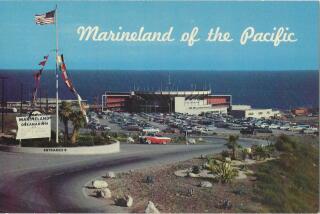Helping the Herd
- Share via
It may be Southern California’s perfect poster mammal--even though it’s an import. The Florida manatee, that endangered denizen of the Sunshine State, demonstrates so many SoCal behaviors that if you put a pair of Jams on it, out-of-staters might mistake it for a native.
Visitors to SeaWorld San Diego can get a peek at the endearing “sea cow” at the park’s new educational Manatee Rescue, the only exhibit of the Florida manatee outside its home state. The park’s 215,000-gallon freshwater aquarium houses five adult males, all graduates of SeaWorld Orlando’s manatee rescue and rehabilitation program.
So, what does this ponderous subspecies of the West Indian manatee have in common with the stereotypical Southern Californian?
Consider this: The Florida manatee is a strict vegetarian, spending up to a third of its day in the wild trolling for underwater and floating vegetation. The five in San Diego--averaging about half a ton apiece--each put away 100 pounds of greens (romaine lettuce is a favorite, no dressing) three times daily, plus treats of grapes, apples, carrots and sweet potatoes.
What’s more, like many of us sun-seekers, the Florida manatee prefers a temperate clime. It is also curious and promiscuous (breeding between consenting manatees goes on pretty much year-round). Additionally, according to SeaWorld’s Web site (https://www.seaworld.org), Florida manatees are gnarly bodysurfers, having been observed riding the current produced by partially opened flood dams.
On opening day, I spent nearly an hour watching the gentle giants glide peacefully past the 100-foot-long viewing windows, seemingly unperturbed by their new environment. Sometimes, between visits to the in-tank salad bar, they’d smoosh their whiskered snoots up against the glass as if to get a better look at their two-legged visitors.
Dan O’Dell, the SeaWorld Orlando biologist who leads the manatee rescue program, said there are only about 2,500 manatees in the wild. Although the manatees have few natural predators, humans pose a great threat; powerboats are one of the leading causes of manatee injury and death. One of the San Diego five is missing large portions of his rear paddle from a run-in with the prop of a powerboat.
O’Dell said the survival rate of the manatees his staff has handled is about 50%, a great increase from the early years.
“No one knew anything about them then,” he said. “But care has improved dramatically . . . especially [for] the orphaned calves. We’re really good at saving them.”
O’Dell said the other four animals in San Diego were either found orphaned and hand-raised or born to pregnant mothers that couldn’t be saved. Although healthy, the quartet is not ready to be released.
“There’s a lot we don’t understand,” O’Dell said. “There’s a lot of learning that goes on between a calf and its mother, like the seasonal migratory patterns. . . . Captive-born calves and hand-raised orphans have never had that experience.
“There is research being done in South Florida, tracking some of the released animals, that’s been fairly successful,” he added. “But we want to play this very conservatively, keep them safe, not just put them back out there and have them hit by boats.”
The Manatee Rescue exhibit includes a video showing the SeaWorld rescue and rehabilitation team in action, as well as a life-size manatee model and other hands-on displays.
About 70 animals handled by the program have been released; the remainder, which include some too badly injured to fend for themselves, are housed in facilities such as SeaWorld Orlando, the Miami Seaquarium and a state wildlife park.
O’Dell, who has spent more than 25 years studying manatees, said the San Diego exhibit and future exhibits at other parks will be helpful in educating the public about the manatee’s plight and what people can do to help.
“I make the comparison in Florida that the manatee is a symbol of the coastal ecosystem; we can’t save the species if we can’t save the habitat.
“People and manatees can get along,” he added. “But people need to change the way they treat the environment.”
And what about the treatment the manatees receive in San Diego?
It’s full service, said senior animal care specialist Mike Bressler, who handles the daily needs of the manatees with associate Kristi Oldham. Bressler said he and Oldham spend about six hours of their shift in the aquarium’s 65- to 75-degree water, securing food underwater and near the surface to simulate natural feeding patterns. They also keep things tidy and make notes to pass on to the veterinarian, who visits the exhibit daily.
On opening day, the animals sometimes seemed to nuzzle the wetsuited keepers as they distributed treats. But Bressler stresses that they are not trying to domesticate them. So, although SeaWorld does have the Shamu shows and others using animals from its collection, don’t expect any staged displays of amusing manatee antics.
“We’re not interested in playing with them,” he said. “We are making every effort to take care of them as best we can in an environment that is as natural as possible.
“Our rehab programs are set that way--for the sea lions, the harbor seals, everything. The goal is to get ‘em healthy and get ‘em back” to the wild.
BE THERE
Manatee Rescue is a permanent exhibit at SeaWorld San Diego, 500 Sea World Drive. Through Sunday: 10 a.m. to 7:30 p.m. daily; thereafter, 10 a.m.-6 p.m. Monday-Friday, 10 a.m. to 7:30 p.m. Saturday-Sunday. (Hours may vary; call ahead.) Admission is $34.95; $26.95 for children 11 and under; children under 3 are free. (619) 222-6363.
More to Read
Sign up for The Wild
We’ll help you find the best places to hike, bike and run, as well as the perfect silent spots for meditation and yoga.
You may occasionally receive promotional content from the Los Angeles Times.






